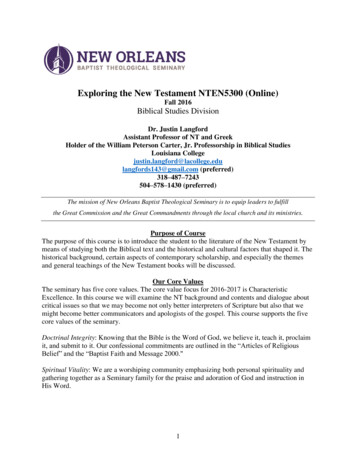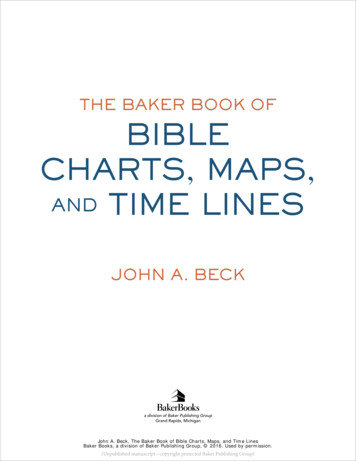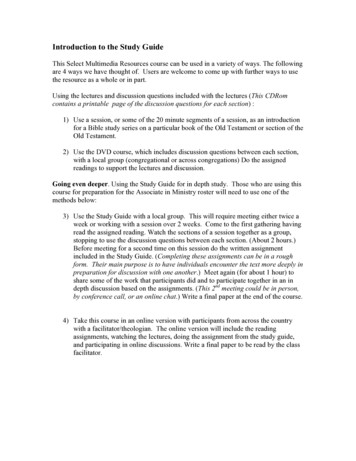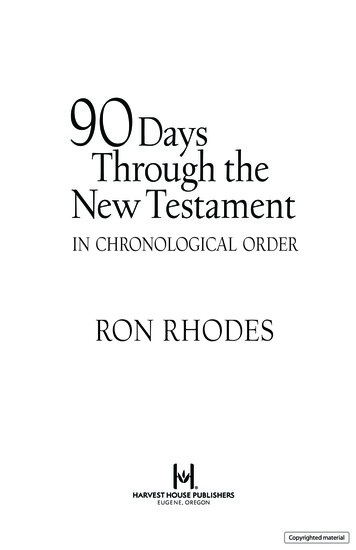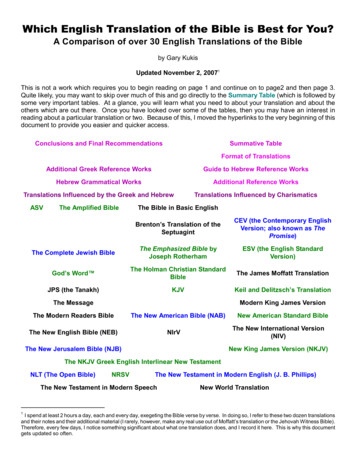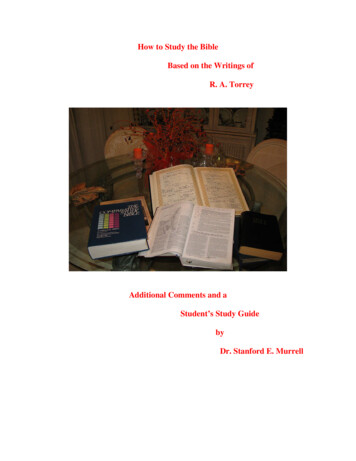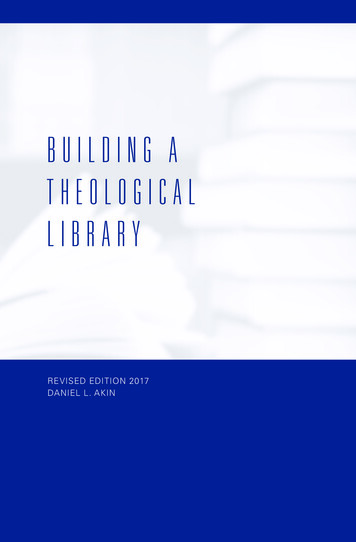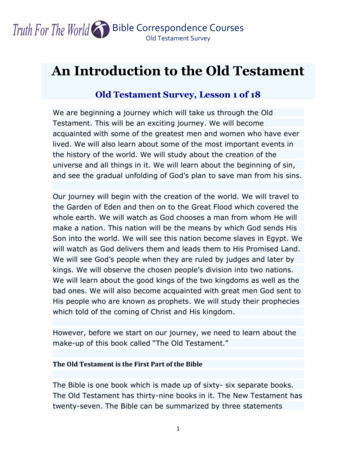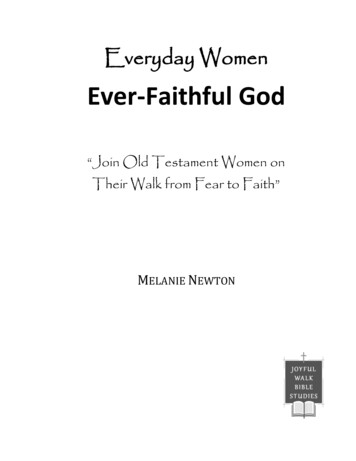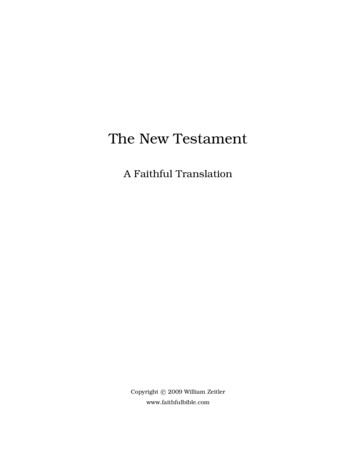
Transcription
The New TestamentA Faithful TranslationCopyright c 2009 William Zeitlerwww.faithfulbible.com
ii
Terms of UseYou are free to make and distribute copies of the Faithful New Testament. There are twoconditions, however:1. You may not sell or charge for the copies in any way. You are welcome to quote from theFaithful New Testament, as long as you credit the source. (“Faithful New Testamentat www.faithfulbible.com”)2. You can’t modify or repackage the Faithful New Testament in any way, or any portionof it. You must give it away complete, and unmodified. You especially can’t change thecopyright.October 20, 2009
ii
TheTheTheTheTheTheTheTheTheTheTheTheTheGospel according to Matthew . . . . .Gospel according to Mark . . . . . . .Gospel according to Luke . . . . . . .Gospel according to John . . . . . . .Acts of the Apostles . . . . . . . . . .Epistle to the Romans . . . . . . . . .First Epistle to the Corinthians . . . .Second Epistle to the Corinthians . .Epistle to the Galatians . . . . . . . .Epistle to the Ephesians . . . . . . . .Epistle to the Philippians . . . . . . .Epistle to the Colossians . . . . . . .First Epistle to the Thessalonians . .Second Epistle to the Thessalonians .First Epistle to Timothy . . . . . . . .Second Epistle to Timothy . . . . . .Epistle to Titus . . . . . . . . . . . . .Epistle to Philemon . . . . . . . . . .Epistle to the Hebrews . . . . . . . . .Epistle of James . . . . . . . . . . . .First Epistle of Peter . . . . . . . . . .Second Epistle of Peter . . . . . . . .First Epistle of John . . . . . . . . . .Second Epistle of John . . . . . . . .Third Epistle of John . . . . . . . . .Epistle of Jude . . . . . . . . . . . . .Book of Revelations . . . . . . . . . .A 4276281284286287301306311314319320321323343iii
ivCONTENTS
PrefaceThe TranslationAs anyone who has studied a foreign language or a foreign culture knows, different peopleshave subtly different ways of viewing the world, and many of these differences are embodiedin their languages. Because of this, the translation process is essentially an attempt toreconcile these differences. Inevitably a translation is a compromise. Languages do notcorrespond one-to-one.Virtually all of the great translations of the New Testament take the approach of makingthe sense of the Original fit ordinary English (or what was at the time ordinary or properEnglish). This is certainly the best approach for a general-purpose translation. The FaithfulNew Testament tries to complement this approach with a translation in which English isused just a little creatively to better convey the sense of the Original.The result, of course, is that the English is a little more awkward. Consequently, TheFaithful New Testament may not be the best choice for quoting scripture passages in publicworship, for example. In fact, we think the best way to use The Faithful New Testament isalongside your favorite translation as a study aid to see more of the detail and power of theOriginal.Example 1English uses the one word “love” for an enormous variety of types of love; the Greek distinguishes them by using different words. The two principle words for “love” used in theNew Testament: are “agape” (“ah-GAH-pay”) and “philia” (“fi-LEE-ah”), and the Faithful NewTestament translates them as “agape-love” and “philia-love” respectively.Some Bible expositors teach that agape-love is “God’s Love” and philia-love is “Man’s Love”.But consider:Men agape-loved the darkness rather than the light, for their works were pernicious. (John 3:19, Faithful New Testament)How can you have “God’s love” for the darkness? And Paul saysIf anyone does not philia-love the lord, let him be accursed. (I Cor. 16:22, FaithfulNew Testament)This would seem to indicate that philia-love is as important as agape-love.In our view, the difference between agape-love and philia-love is along the lines of thedifference between “love as commitment” and “love as feeling”. But you don’t have to takeour word for it: the Faithful New Testament enables the English reader to know immediatelywhich of these two words for “love” is used in any passage, which ultimately is the decisiveway to understand the different meanings.Making clear the different Greek words for “love” in the English sometimes dramaticallyclarifies otherwise confusing passages. For example, in the following passage, the resurrected Jesus is talking to Peter, who had so recently denied Jesus three times (bold isadded):v
viCONTENTSKing James:So when they had dined, Jesus saith to Simon Peter, “Simon, son of Jonas, lovestthou Me more than these?” He saith unto Him, “Yes, Lord; Thou knowest thatI love Thee.” He saith unto him, “Feed my lambs.” (16) He saith to himagain the second time, “Simon, son of Jonas, lovest thou Me?” He saithunto Him, “Yes, Lord, Though knowest that I love Thee.” He saith unto him,“Feed My sheep.” (17) He saith unto him the third time, “Simon, son of Jonas,lovest thou Me?” Peter was grieved because He said unto him the third time,“Lovest thou Me?” and he said unto Him, “Lord Thou knowest all things;Thou knowest that I loveth Thee.” Jesus saith unto him, “Feed My sheep.”(John 21: 15-17)Faithful New Testament:When therefore they ate breakfast, Jesus says to Simon Peter: Simon son ofJohn, do you agape-love me more than these? He says to them: Yes, Lord,you know that I philia-love you. He says to him: Be feeding my lambs. (16) Hesays to him again a second time: Simon son of John, do you agape-love me?He says to him: Yes Lord, you know that I philia-love you. He says to him:Be shepherding my sheep. (17) He says to him the third time: Simon Peter, doyou philia-love me? Peter was grieved because he said to him the third time:Do you philia-love me? And he said to him: You know everything, you knowthat I philia-love you. Jesus says to him: Be feeding my sheep. (John 21:15-17)The first two times Jesus asks Peter if he agape-loves Him, Peter replies that he philialoves Him; the third time when Jesus asks Peter if philia-loves Him (which Peter hadalready said twice that he does), Peter is upset. It’s interesting that Jesus questions Peterthree times—the same number of times that Peter had denied Him.Example 2To a surprising degree, translators sometimes pass over details of the meaning of the Original unnecessarily (in our view). For example, the phrase “the kingdom of heaven,” whichappears so frequently in Matthew’s gospel, is not singular, it’s plural:Matt.5:3:Blessed are the poor in the spirit For theirs is the kingdom of the heavens.Faithful New TestamentBlessed are the poor in the spirit for theirs is the kingdom of heaven. KingJamesBlessed are the poor in the spirit For theirs is the kingdom of heaven. RSVBlessed are the poor in the spirit For theirs is the kingdom of heaven. NASBBut in other passages, the New Testament uses “heaven” singular, such as in the Lord’sPrayer:Your kingdom come, your will come to pass, as in [heaven], so also on [the] earth.(Matt.6:10)The Faithful New Testament takes the position that details in the Original like singularand plural should be translated literally as much as possible—especially when they can betranslated by perfectly normal English—so English readers can assess the significance forthemselves.Example 3Greek makes its negatives more emphatic by doubling and sometimes tripling them. TheFaithful New Testament indicates a double negative by underlining the word “not,” a triple
CONTENTSviinegative by underlining the word “NOT” (all capital letters):Heb.13:5I will not abandon you, and I will NOT forsake you. Faithful New TestamentI will never leave thee, nor forsake thee. King JamesNever will I leave you; never will I forsake you. RSVI will never desert you, nor will I ever forsake you. NASBAlthough double negatives are fairly common, triple negatives are quite rare, only occurring a half dozen times in the entire New Testament. To have both a double and a triplenegative in the same sentence is extremely unusual. With the Faithful New Testament,English readers can see for themselves the powerful emphasis in the Original: “I will notabandon you, and I will NOT forsake you”. This powerful emphasis is completely lost inother translations.Or consider (Mark 14):(22) And while they were eating, taking bread [and] having blessed [it] he brokeand gave [it] to them and said: Take, this is my body. (23) And taking the cup[and] having given thanks he gave [it] to them, and they were all drinking of it.(24) And he said to them: This is my blood of the a contract being poured outin behalf of many. (25) Truly I say to you that I will NO LONGER drink of theproduce of the vine until that day when I drink it new in the kingdom of God.In this passage, “NO LONGER” is a rare triple-negative—the strongest negative that can beexpressed in Greek.Example 4In various passages, the New Testament is much more forceful than would appear in othertranslations:And behold a leper, having come, prostrated himself before him saying: Lord,if you wish it, you are able to cleanse me. And stretching out his hand hegrasped him saying: I wish it, be cleansed. (Matt.8:2-3)Generally verse 3 is translated “. . . he touched him. . . ”, which suggests that perhapsJesus just barely touched the leper. But the Original makes clear that he grasped the leper- a truly shocking and fearless act. (Imagine confidently grasping someone with a horrifyingdisease that is transmitted by touch.)Matt.8:3And stretching out his hand he grasped him. Faithful New TestamentAnd Jesus put forth His hand, and he touched him. King JamesAnd Jesus put forth His hand, and he touched him. RSVAnd Jesus put forth His hand, and he touched him. NASBExample 5Matt.13:35I will open my mouth in parables,I will shout things secretFrom the foundation of the world. Faithful New TestamentI will open my mouth in parables,I will utter things which have been kept secretFrom the foundation of the world. King Jamesa insert“new” K vg many; text: ℵBD
viiiCONTENTSI will open my mouth in parables,I will utter what has been hiddensince the foundation of the world. RSVI will open my mouth in parables;I will utter things hiddensince the foundation of the world. NASBThe verb translated as “shout” in the Faithful New Testament (and “utter” in the others)is used in the Greek to describe the eruption of volcanoes and other forceful discharges—hardly a mild-mannered “utter”!Example 6Greek verbs can express “continual action” - action that takes place over a period of time,versus “point” or “matter-of-fact” action - action that takes place essentially at one point intime. For example:“Now Krispus, the chief of the synagogue, believed [“point action” or “matter offact”] in the Lord with his whole house, and many of the Corinthians, havingheard [”point action” or ”matter of fact”], were believing [“continual action”]and were being baptized [”continual action”].In the case of imperatives especially, the type of action can deepen the meaning considerably. Matt.7:7 is usually translated “Ask . Seek . Knock . ”, implying that one needonly ask, seek or knock once, whereas the Original makes it clear that a continual courseof action is required: “Be [continually] asking .” (that is, don’t stop!) English is perfectlycapable of expressing these kinds of distinctions:Be asking, and it will be given to you;be seeking and you will find; be knocking,and it will be opened to you. Faithful New Testament Matt. 7:7Ask, and it shall be given to you;Seek, and you will find; knock, and it will beopened unto you. King JamesAsk, and it will be given you;seek, and you will find; knock, and it will be openedto you. RSVAsk, and it will be given to you;seek, and you will find; knock, and it will beopened to you. NASBExample 7The Faithful New Testament also translates “technical terms” of the New Testament, suchas “sin,” “justice,” “soul,” by the same English word throughout. The intent is to enablethe reader to identify the same important Greek word in its various contexts, which is theonly real basis for understanding its meaning as the New Testament uses it. Each Greek“technical” term is translated by one English word, e.g. DIKE (“DIH-kay”) as noun, verb, andadjective is translated “Justice,” “Justify,” and “Just.” “Justice” is never used to translateany other Greek word. In those cases when it is impossible to translate a Greek “technicalterm” by its usual English word, a reference in the footnote will indicate what would havebeen the usual English “technical term:”. . . they have been entrusteda the words of God.(footnote:)afrom “BELIEF”meaning that “entrusted” corresponds to the same Greek word which is usually translated“believe.”Example 8There are two principle words for “love” used in the New Testament: “agape” (“ah-GAH-pay”)and “philia” (“phi-LEE-ah”). Since English uses the same word “love” for so many kinds of
CONTENTSixlove that are distinguished in the Greek, the Faithful New Testament translates them as“agape-love” and “philia-love” respectively.Some Bible expositers teach that agape-love is “God’s Love” and philia-love is “Man’s Love”.But consider:Men agape-loved the darkness rather than the light, for their works were pernicious. (John 3:19)How can you have “God’s love” for the darkness? And Paul saysIf anyone does not philia-love the Lord, let him be accursed. (I Cor. 16:22)This would seem to indicate that philia-love is as important as agape-love. The Faithful NewTestament enables the English reader to know immediately which of these two words for“love” is used in any passage. (The very few cases where other Greek words for “love” areused are indicated in footnotes.)(In our opinion, the difference between agape-love and philia-love is along the lines thatagape-love is “love as commitment”, where philia-love is “love as emotional connection”.Thus, when an infant is inconsolable at 3am, her parents may unquestioningly agape-lovetheir child, but they may not philia-love her very much in that moment!)Making clear the different Greek words for “love” in the English sometimes dramaticallyclarifies otherwise confusing passages. In the following passage, the resurrected Jesus istalking to Peter, who only days previous had denied Jesus three times:When therefore they ate breakfast, Jesus says to Simon Peter: Simon Peter, doyou agape-love me more than these? He says to them: Yes, Lord, you knowthat I philia-love you. He says to him: Be feeding my lambs. (16) He saysto him again a second time: Simon son of John, do you agape-love me? Hesays to him: Yes Lord, you know that I philia-love you. He says to him: Beshepherding my sheep. (17) He says to him the third time: Simon Peter, doyou philia-love me? Peter was grieved because he said to him the third time:Do you philia-love me? And he said to him: You know everything, you knowthat I philia-love you. Jesus says to him: Be feeding my sheep. (John 21:15-17)Example 9Words which are implied by Greek grammar but are not, strictly speaking, found in theoriginal are in square brackets:But the sting of death [is] sin, and the power of sin [is] law. (I Cor. 15:56)Idioms are translated literally when they are comprehensible:And boiling in the spirit, he was speaking and teaching carefully concerningJesus . . (Acts 18:25)Mary . was found having [life] in the belly (Matt 1:18)The Underlying TextIn keeping with the principle of presenting the English reader more detail of the meaning ofthe Original, the Faithful New Testmament also tries to present the English reader with thedetails of the underlying textual tradition that forms the basis of the Greek New Testament.Instead of saying “Other ancient manuscripts say.”’, the Faithful New Testament actuallylists the manuscripts, so readers can make up their own minds.Since we are not in possession of any manuscripts of the New Testament books old enoughto be the very original copies (that is, in Matthew’s or Paul’s handwriting), it has been necessary to rely on copies of copies that have survived. Considering that there are 3000 partial
xCONTENTSor complete copies of the New Testament, not including quotes from the New Testament bythe early Christian writers (whose quotations from the New Testament are so extensive thatthe entire New Testament could be reconstructed from them alone), and not including earlytranslations of the New Testament into Old Latin, Syriac, etc., it is surprising that there isas little disagreement among these “copies of copies” as there is.Most of these disagreements, or “variant readings,” involve different spellings of propernames and such—not enough difference to be translatable, really. Those variant readingsof the Greek wording that change the meaning to an extent that can be translated and whichare supported by a significant manuscript or group of manuscripts have been recorded infootnotes. The Faithful New Testament also gives some indication of which manuscriptshave which wording.***The number of pre-300 manuscripts in existence is small (50?). With the legalization ofChristianity by Constantine (who became Emperor in 311), the number of New Testamentdocuments exploded. At the same time, the Roman Empire was splitting into three political/economic entities: the West (the Holy Roman Empire), Byzantium (with Constantinopleas its capital), and Egypt (with Alexandria as its capital).Before 300, in the height of Christian missionary activity, manuscripts of the New Testament found their way throughout the Mediterranean region; after 300, as a result of thepolitical and economic barriers, variant readings began to group themselves geographicallyinto the “Western,” “Alexandrian,” and “Byzantine” types of text. That is, manuscripts prepared in the same locale tended to read the same way.In the footnotes, therefore, is an indication of that portion of the text which is in dispute,and the alternative reading(s), each followed by symbols which indicate which manuscriptssupport them (these symbols are familiar to any New Testament textual scholar):K (from the Greek word “koine” (“koy-NAY”) which means “common”) means that the Byzantine textual tradition as a whole supports this reading. Since the Byzantine Empire surviveduntil 1453, copying of the New Testament continued undisturbed in the Byzantine area upto modern times. The overwhelming majority of Greek manuscripts that have survivedare Byzantine in character, though most Byzantine manuscripts are not old enough to bevery helpful in determining the original wording. The Byzantine is that type of Greek textprimarily used by the King James translators.H (from “Hesychios” which means “of Egypt”) means that the Alexandrian textual tradition as a whole supports this reading. There are not nearly as many Alexandrian typemanuscripts since copying the New Testament was not exactly encouraged by the Moslemswho conquered this region. The Alexandrian is that type of Greek text primarily used bythe Revised Standard Version translators.The Western tradition—the West being the region of the Holy Roman Empire, is representedby very few Greek manuscripts since Latin was the official language of the Catholic Church,and is mostly represented by early Western Christian writers and by the Latin translations.Since there really is no Western Greek manuscript tradition (in the same way that there isa Byzantine and Alexandrian), the Faithful New Testament includes instead:vg (“vulgate”) a translation of the Bible into Latin made around 700 by Jerome (Western incharacter).The Western is that type of Greek (and Latin) text underlying the Catholic translations,such as the Confraternity.Also cited in the footnotes are some of the most important individual New Testamentmanuscripts:ℵ “Codex Sinaiticus” (4th century) Discovered in a monastery in 1844 by the preeminent19th century textual scholar Constantinus Tishendorf. ℵ is “aleph,” the first letter of the
CONTENTSxiHebrew alphabet.A “Codex Alexandrinus” (5th century)B “Codex Vaticanus” (4th century) regarded as AlexandrianD “Codex Bezae” (4th, 5th century) Western in characterW “Codex Washingtoniensus” (4th, 5th century) mixed in character.p45 , p66 etc. Early Papyri, generally 3rd century. The papyri, although mostly found in Egypt(the dry desert air preserves them), do not side with any of the text types in particular.Thus, for example:(Matt 5:) (22) But I say to you that everyone [being] angry with his brothera willbe liable for judgment.(See the footnote at the bottom of the page.) This means that Codex Bezae, Codex Washingtoniensus, the Koine (Byzantine) tradtion, and most manuscripts read “angry withoutcause”, but that Codex Sinaiticus, Codex Alexandrinus, a few other manuscripts, and papyrus 67 read as translated in the “text” (that is, they don’t include “without cause”).The most commonly held view today is that the Alexandrian tradition as a whole is themost reliable, because it has the oldest manuscripts. Within this body of opinion there aredisagreements as to which particular Alexandrian manuscripts are the most reliable, etc.But overall this is the prevailing view today.Regarding which text I incorporate into the text (and consequently which readings I relegateto the footnotes): I subscribe to the view that the best choice of text is that supported bythe broadest base of early sources. Thus, if a reading appears in, say, the West and in earlypapyri, this means (to me) that the reading had to have a much earlier common source. Idon’t subscribe to the view of simply going with the reading supported by the single oldestmanuscript (maybe that one copyist was particularly careless), or even manuscript tradition(namely the Alexandrian).There are readings that are only supported by the Byzantine tradition and the earliest papyri (with the Alexandrian tradition reading differently), as well as lists of readings onlysupported by the Alexandrian tradition and the earliest papyri (with the Byzantine tradition reading differently). Thus the blind acceptance of the Alexandrian tradition is a weakposition, in my opinion.Another view holds that the Byzantine textual tradition is ’the best’ because it has the greatest sheer number of manuscripts (alas, most of which are relatively late) and a relativelyunbroken tradition up to the Renaissance (alas, more opportunity for scribal error).Significant variants (differences sufficient to alter the English translation) are in the footnotes, so you can assess them for yourself.a insert“without cause” DWK most; text: ℵ B few vg p67
xiiCONTENTS
The TextThe Gospel according to MatthewMatthew 1The Genealogy of Jesus Christ1The scrolla of [the] lineage of Jesus Christ, son of David son of Abraham:2Abraham begatb Isaac,and Isaac begat Jacob,and Jacob begat Judah and his brothers,3and Judah begat Perezand Zarah by Tamarc ,and Perez begat Hezron,and Hezron begat Aram,4and Aram begat Aminadab,and Aminadab begat Nahshon,and Nahshon begat Salmon,5and Salmon begat Boaz by Rahabd ,and Boaz begat Obed by Ruthe ,and Obed begat Jesse,6and Jesse begat King David.And David begat Solomon by the [wife] of Uriahf .And Solomon begat Rehoboam,and Rehoboam begat Abijah,and Abijah begat Asaph,8and Asaph begat Jehoshaphat,and Jehoshaphat begat Joram,7a BIBLOS (βιβλoς) The word comes from byblos, which denoted the papyrus plant that grew in marshes or riverbanks, primarily along the Nile. Writing material was made from the papyrus plant by cutting the pith of the plantin one foot strips and setting it in the sun to dry. The strips were then laid in horizontal rows with rows of verticalstrips glued to the horizontal rows in a criss-cross fashion similar to the way plywood is constructed today. Thehorizontal rows were smoother and became the writing surface. Sections of these strips were glued together toform a scroll up to thirty feet in length.Books as we know them weren’t invented until sometime in the 2nd through 4th centuries. Thus, in the 1stcentury they would still have been using scrolls.b GENNAO “gen-AH-oh” (γ νναω) is used of ‘begetting’ by the father, and ‘birthing’ by the mother in the Greekliterature in general as well as the Septuagint. Thus it refers to the reproductive process as a whole. GENNAOis also used of the special relationship between a Master and his disciples, where no literal begetting or birthingis involved. Since there isn’t really an English word that encompasses the whole reproductive cycle, GENNAO isreluctantly translated as ’born’ except in those contexts where it would be strange to the English reader to say’born of a father’ or ’begotten by a mother’.c Gen.38:12–19d Josh.2:1e Ruth 3:1–14f 2 Sam.11:2–51
2CONTENTSand Joram begat Uzziah,9and Ussiah begat Jotham,and Jotham begat Ahaz,and Ahaz begat Hezekiah,10and Hezekiah begat Manasseh,and Manasseh begat Amos,and Amos begat Josiah,11and Josiah begat a Jechoniah and his brothers in the time of the Babylonian exile.12After the Babylonian exile, Jechoniah begat Salathiel,and Salathiel begat Zerubbabel,13and Zerubbabel begat Abiud,and Abiud begat Eliakim,and Eliakim begat Azor,14and Azor begat Zadok,and Zadok begat Achim,and Achim begat Eliud,15and Eliud begat Eliezer,and Eliezer begat Matthan,and Matthan begat Jacob,16and Jacob begat Joseph the husband of Mary,by whomb was born Jesus the [one] being called Christ.17Therefore all the generations from Abraham until David [are] fourteen generations, andfrom David until the Babylonian exile [are] fourteen generations, and from the Babylonianexile until the Christ [are] fourteen generations.The Birth of Jesus Christ18Now the birth of Jesus Christ was thus: Mary his mother having been betrothed toJoseph, before they came together c she was found having [life] in the belly by the HolySpirit. 19 And Joseph her husband-to-be, being just, and not wishing to put her to openshamed , purposed to dismiss her secretly. 20 So having pondered these [things], behold[an] angel of the Lord in a dream appeared to him saying: Joseph son of David, you shouldnot fear to take to yourself Mary your wife. For what has been conceived in her is by theHoly Spirit. 21 And she will bring forth [a] son, and you will call his name Jesus, for hehimself will save his people from their sins. 22 This whole [thing] came about so that the[things] said by the Lord through the prophet be fulfilled when he sayse :Behold a virgin f will have [life] in the bellyAnd will bring forth [a] son,And they shall call his name “Emmanuel” g23a insert “Joachim; and Joachim begat” few [it won’t be fourteen generations if this reading is included. See vs.17]; as the text reads: ℵBW vg KH allb “whom” is feminine, thus referring to Maryc The connotation of the Greek is ‘before they came together in marital and domestic union’. See Danker (2000)970 (s.v. συν ρχoµαι)d In those days, being pregnant out of wedlock could get you stoned to death (see Deut.22:22). In the Jewishcontext, “full betrothal was so binding that its breaking required a certificate of divorce, and the death of one partymade the other a widow or widower”. See NET (2003), 2, fn. 8e Isa.7:13–15f Opinions vary on the word PARTHENOS (παρθ νoς), here translated “virgin”. Danker (2000), a lexicon forspecifically N.T Greek, says this word means ’virgin’. LS (1996), however, a lexicon for Ancient Greek literaturein general, says “maiden”, “young girl”, and cites instances of PARTHENOS (in Sophocles, for example) where itrefers to unmarried non-virgin women. However, if the sense is merely ‘young girl’, then this ‘fulfilled prophecy’becomes meaningless as young women have been conceiving since time immemorial. Also, the context says thatMary conceived ‘by the Holy Spirit’, before she and Joseph ‘came together’. Thus the Gospel’s author clearly musthave had ‘virgin’ in mind.g Curiously, there is no record of anyone actually calling Jesus ‘Emmanuel’.
THE GOSPEL ACCORDING TO MATTHEW3which is, being translated: “God [is] with us.” 24 And Joseph having arisen from his sleep,did as the angel of the Lord ordered, and took to himself his wife. 25 And he did not knowher until she brought forth [a]a son, and she called his name Jesus.Matthew 2The Visit of the Wise Men1Now when Jesus was born in Bethlehem of Judea in the days of Herod the king, beholdvisionariesb from the east arrived in Jerusalem 2 saying: Where is the [one] having beenbrought forth, [the] king of the Jews? For we saw his star in the East and came to worshiphim. 3 Now having heard [this] Herod the king was troubled, and all Jerusalem with him. 4And gathering all the chief-priests and scribes of the people he asked from them where theChrist would be born. 5 And they said to him: In Bethlehem of Judea. For thus it is writtenby the prophetc ,6And you Bethlehem, land of JudahIn no way are you least among the rulers of JudahFor out of you shall come [a] rulerWho will shepherd my people Israel.Then Herod having secretly called the visionariesd , he exacted from them the time of theappearance of [the] star, 8 and having sent them to Bethlehem he said: Having gone, searchout accurately concerning the child, and when you find him, report to me, so that I also,having come, may worship him. 9 So having heard [this] from the k
Some Bible expositors teach that agape-love is “God’s Love” and philia-love is “Man’s Love”. But consider: Men agape-loved the darkness rather than the light, for their works were perni-ciou

